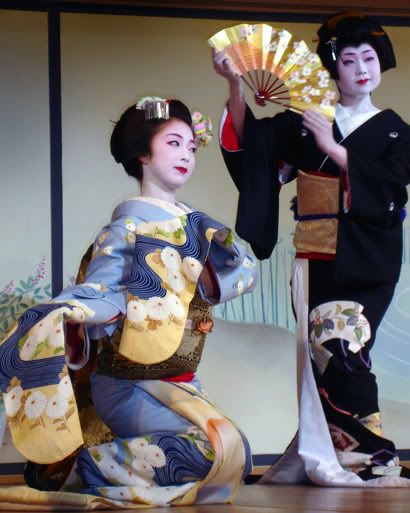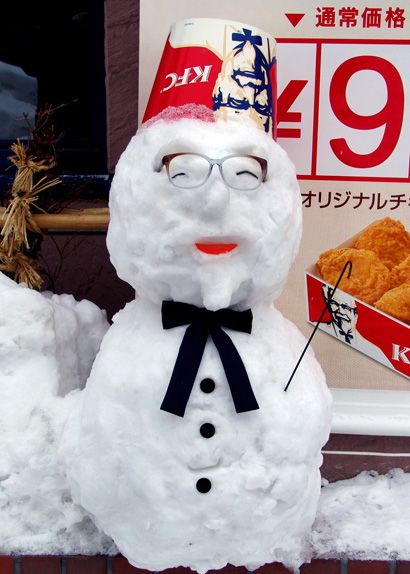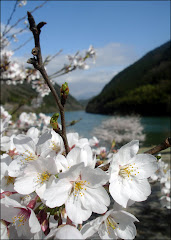
Wednesday, April 26, 2006
Tuesday, April 25, 2006
Maiko-han of Miyagawa: Kyo Odori Finale

Excerpt from the 57th Annual Kyo Odori Program:
The long cold winter gives way at last to the arrival of spring in the ancient capital of Kyoto, and the Kyo Odori is always a welcome and colorful addition to this flower-filled season.
Famous for their beauty, the geisha and maiko of Miyagawa-cho grace the Kyo Odori stage to offer lively, fun, and elegant portrayals of seasonal culture, local flavor, and stories that developed in places throughout Kyoto...
Time always seems short,but we hope that the seven scenes of this year's performance, Seasonal Glories of the Capital, will provide a sense of the tradition and beauty embodied in the local performing arts.
Monday, April 24, 2006
Kimika's Beautiful Kimono
Kimika strikes a pose during a peice entitled "Colorful Scenes of Kyoto," showing off the breath-taking yuzen design on the long, flowing sleeves of her kimono. Kimika is a young maiko, or apprentice geiko, in Miyagawa-cho, one of Kyoto's Gohanamachi (literally 5 Flower Towns), or geiko entertainment districts. (57th Annual Kyo Odori).
I LOVE KYOTO
Thursday, April 20, 2006
Touge & The Fast and the Furious: Tokyo Drift
 Watch the the trailer for Tokyo Drift!
Watch the the trailer for Tokyo Drift!
Ever heard of Touge (pronounced toh-gay)? Doubtful, but the chances are you've heard of drifting. If not, you're about to get a crash course a la Hollywood: Fast and furiously. Quickly catching on in the States and abroad, this new racing craze's roots run deep through the twisiting, turning, roads of Japan. Touge itself refers to the mountain passes that wind their way through the mountainous terrain of the Japanese archeapelago.

Drifting is the controlled loss of traction, causing a car to appear as though it is out of control. Nothing, however, could be further from the truth. A good drifter is in control of his car at all times, easily taking on five or six opposing turns without traction, at speeds of over 80mph, cutting angles of 45 degrees or more. As if that isin't potentially dangerous enough, in tougue, this is all done with the loving embrace of a wall of rock to one side and the comfort of a sheer drop off a cliff on the other. In a battle, the lead car wins if the gap between the cars increases -- the following car wins if the gap stays the same from start to finish.
"How?" You ask? In the words of Keiichi Tsuchiya, the one and only Drift King, and inspirational model for the main character in the popular manga series, Initial D (Kashiramoji D):
"You brake and then turn the wheel, step on the clutch, and pull the e-brake. Release the e-brake, go into countersteer mode, then wait. Wait until you know the car is facing the corner exit direction. then you smile and slam on the gas as you exit the corner."
There you go. Easy as that!
Thus the mission to infiltrate the scene begins...
Wednesday, April 19, 2006
The Plumpkey
The Plumpkey '
Thursday, April 13, 2006
桜咲いているね!Sakura \(^-^)/

Sakura, or Cherry Blossoms, line the ragged, rocky bank of the Kiso River that flows past my beautiful mountain school. The trees have been in bloom all week, but today is the first day it hasn't rained, making this chance to enjoy the fragile beauty of these short-lived blooms all the more precious.
Spring buds burst, and so I gaze,
Blossoms fall, and so my days
Bassho, Haiku Master
The tradition of hanami, literally meaning flower viewing, is centuries old. It was once believed that cherry blossoms were the most accurate indicators of the coming harvests. If the blooms were full then the merchant classes would party and parade in their best kimonos, as it predicted a bountiful rice harvest. The traditional appeal of cherry blossom viewing is also said to lie in its poignant reminder of the fragile beauty and brevity of life.
By the end of the 17th century the hanami party had become a ritual popular across all social classes, and the tradition continues today as friends and families gather for picnic parties under the huge cherry trees, armed with bento boxes filled with delicious treats, beer and sake.
A lot of planning goes into hosting the perfect hanami party. Securing the right position could involve laying your mat before 8am and some even hire a person to reserve their space. Cunning corporates send their junior employees out before sunrise to stake a claim on the prime picnic spot for their company function, partly explaining the many young men in suits found snoozing under the trees while they await the arrival of food, drinks and guests.
TV stations give weather forecasts with blossom blooming predicitions and updates, while newspapers print maps with tiny pink dots to pinpoint the best hanami locations for this much anticipated event but you'll need to arrive very early at famous blossom-viewing venues such as Tokyo's Ueno Park Osaka Castle, or Maruyama Park in Kyoto. Hanami comes but once a year! Kampai!
Sunday, April 09, 2006
Friday, April 07, 2006
Winter in Review
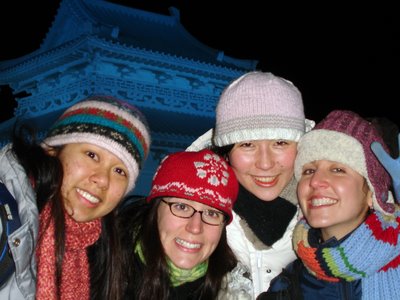 Punnada, Katie, Hanako and I infront of a huge snow temple at the 'world famous' Snow Festival in Sapporo, Hokkaido. "Say Cheezu?" More like "Freezu!" And don`t try to diss the gear...You know you`re jealous of my floppy-eared fro-warmer!
Punnada, Katie, Hanako and I infront of a huge snow temple at the 'world famous' Snow Festival in Sapporo, Hokkaido. "Say Cheezu?" More like "Freezu!" And don`t try to diss the gear...You know you`re jealous of my floppy-eared fro-warmer!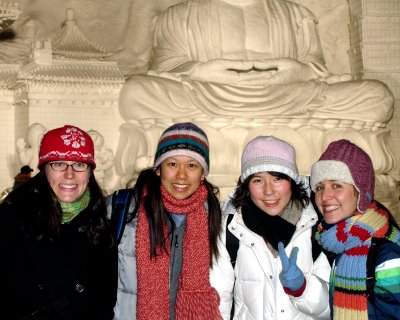 Freezing infront of Hong Kong's panoramic wall of snow sculpted into a ...headless Buddah? Wow! We almost made it with out the peace sign...Way to go Hanako. Pshh.
Freezing infront of Hong Kong's panoramic wall of snow sculpted into a ...headless Buddah? Wow! We almost made it with out the peace sign...Way to go Hanako. Pshh. An exact replica (on a slightly smaller scale, and minus the wood) of Horyuji, the oldest wooden structure in the world.
An exact replica (on a slightly smaller scale, and minus the wood) of Horyuji, the oldest wooden structure in the world.
Holy Snow Batman!
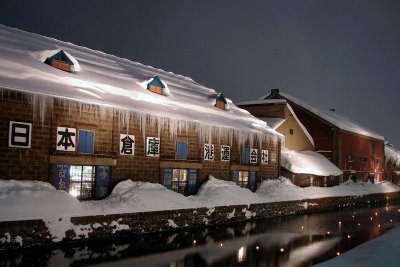 The quaint canal town of Otaru had its own little ice lantern festival going on (the lights in the canal are floating candles), but the best thing about this place was its sushi! Ooishiiiiii yo!
The quaint canal town of Otaru had its own little ice lantern festival going on (the lights in the canal are floating candles), but the best thing about this place was its sushi! Ooishiiiiii yo!
 A Batman's-eye-view of the main venue from the TV Tower.
A Batman's-eye-view of the main venue from the TV Tower.


